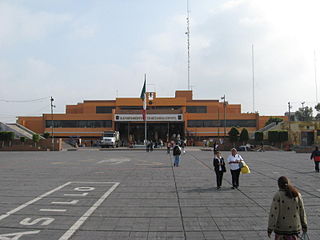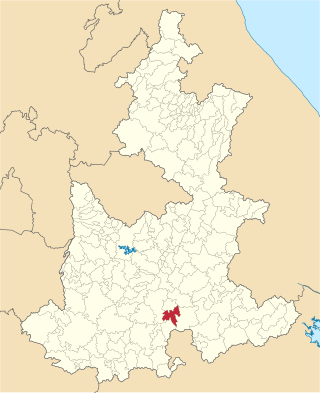
Tlaxcala, officially Tlaxcala de Xicohténcatl, is the capital city and of the Mexican state of Tlaxcala and seat of the municipality of the same name. The city did not exist during the pre-Hispanic period but was laid out by the Spanish as a center of evangelization and governance after the Spanish conquest of the Aztec Empire. The city was designated as a diocese but eventually lost that status to Puebla as its population declined. The city still has many of its old colonial structures, including the former Franciscan monastery, and newer civic structures like the Xicohtencatl Theatre.

The State of Mexico, officially just Mexico, is one of the 32 federal entities of the United Mexican States. Commonly known as Edomex to distinguish it from the name of the whole country, it is the most populous, as well as the most densely populated, state in the country.

El Porvenir is a municipality and township in the Mexican state of Chiapas.

Ixtapaluca is a city and a municipality in the eastern part of the State of Mexico in Mexico. It lies between Mexico City and the western border of the state of Puebla. The name Ixtapaluca means "Where the salt gets wet".
Acayucan Municipality is a municipality in the Mexican state of Veracruz. It is located in the state's southeast, in the Olmeca region. The municipal seat is the city of Acayucan, Veracruz. It covers a total of 724.65 km2.

Zihuatanejo de Azueta is a municipality in the Mexican state of Guerrero. It includes the major resort communities of Zihuatanejo and Ixtapa in addition to numerous other towns. In 2010 it had a population of 118,211 inhabitants. It has an area of 1468 km². Its municipal seat is the city of Zihuatanejo. Its municipal president for the 2005-08 period was Silvano Blanco Deaquino.

Nezahualcóyotl, or more commonly Neza, is a city and municipal seat of the municipality of Nezahualcóyotl in Mexico. It is located in the state of Mexico, adjacent to the east side of Mexico City. The municipality comprises its own intrastate region, Region IX.
The Instituto Nacional para el Federalismo y el Desarrollo Municipal is a decentralised agency of the Mexican federal government. It has responsibility for promoting the ideals of federalism between the several levels of government in Mexico, by acting to coordinate and implement policies, programmes and services that are designed to strengthen inter-governmental relations between the federal and "subsidiary" levels of governance at the state and municipal levels.
Chalma is a municipality in the Mexican state of Veracruz.
El Higo is a municipality of the Mexican state of Veracruz. It is located in the state's Huasteca Alta region. The municipal seat is the village of El Higo, Veracruz.

Pánuco is a municipality in the Mexican state of Veracruz. It is located in the Huasteca Alta region of Veracruz and shares borders with the states of San Luis Potosí and Tamaulipas. The municipal seat is the city of Pánuco, Veracruz.
Pilcaya is a municipality in the Mexican state of Guerrero. The municipal seat lies at Pilcaya. The municipality covers an area of 62.1 km².
Xochistlahuaca Municipality is a municipality in the Mexican state of Guerrero. The municipal seat lies at Xochistlahuaca. The municipality covers an area of 321.1 km².

Coyotepec is a municipality in the Mexican state of Puebla. The name comes from the Nahuatl words coyotl (coyote) and tepetl (hill)

Nealtican (municipality) is a municipality in the Mexican state of Puebla in south-eastern Mexico. The municipal seat is the town of San Buenaventura Nealtican.

San Salvador Huixcolotla is a town and municipality in the Mexican state of Puebla in southeastern Mexico that may be best known as the birthplace of papel picado. San Salvador is of Spanish origin and translates to "Holy Savior" and Huixcolotla is Nahuatl for "place of the curved spines".

Zacatlán Municipality is a municipality in the Mexican state of Puebla in south-eastern Mexico. Its administrative centre is the city of Zacatlán.
Tlaxcala is a municipality in the central Mexican state of Tlaxcala. The municipal seat is the city of Tlaxcala de Xicohténcatl, which also serves as the state capital.
Álamos Municipality is a municipality in south-western Sonora, Mexico. It includes the town of Álamos.

Tlaxcala handcrafts and folk art is that which comes from the smallest state in Mexico, located in the center-east of the country. Its best-known wares are the "canes of Apizaco", sawdust carpets and the making of Saltillo-style serapes. However, there are other handcraft traditions, such as the making of pottery, including Talavera type wares, cartoneria, metalworking and stone working. The state supports artisans through the activities of the Fideicomiso Fondo de la Casa de las Artesanía de Tlaxcala















